PCIe SSD Faceoff: Samsung XP941 (128GB & 256GB) and OCZ RevoDrive 350 (480GB) Tested
by Kristian Vättö on September 5, 2014 3:00 PM ESTRandom Read/Write Speed
The four corners of SSD performance are as follows: random read, random write, sequential read and sequential write speed. Random accesses are generally small in size, while sequential accesses tend to be larger and thus we have the four Iometer tests we use in all of our reviews.
Our first test writes 4KB in a completely random pattern over an 8GB space of the drive to simulate the sort of random access that you'd see on an OS drive (even this is more stressful than a normal desktop user would see). We perform three concurrent IOs and run the test for 3 minutes. The results reported are in average MB/s over the entire time.

Random read performance remains unchanged for the XP941 despite the lower capacity, while the RevoDrive does not really enjoy any performance increase over other SandForce based SSDs.
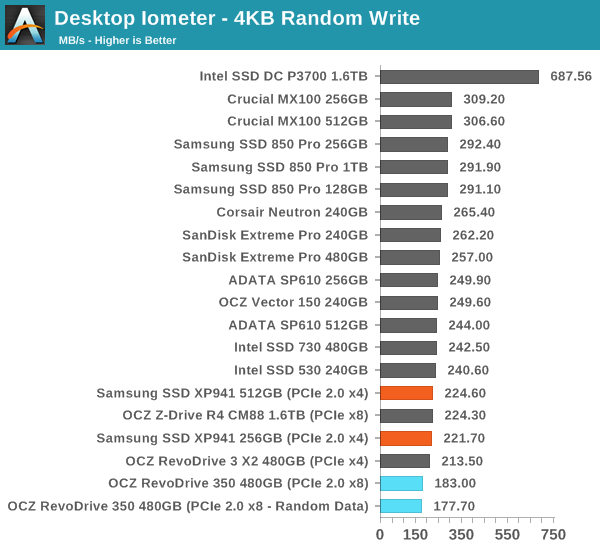
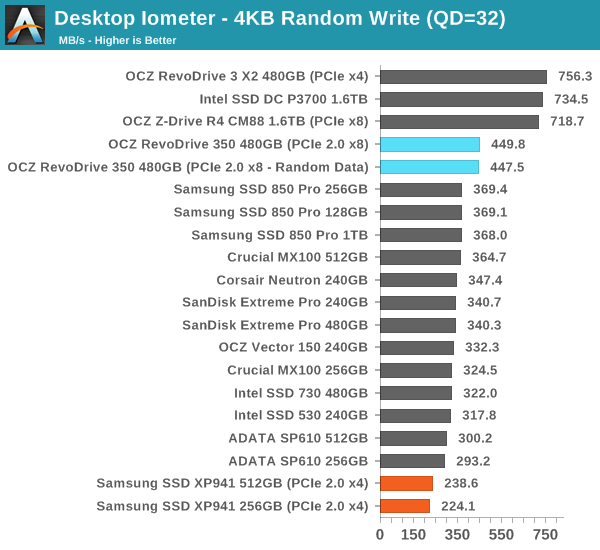
As for random write, the 256GB XP941 appears to be almost a match for the 512GB. The RevoDrive is a fairly interesting case because at low queue depths its performance is pretty bad, but the performance scales with the queue depth. Again, RAID only helps when there are multiple IOs in parallel, which only happens at high queue depths. At low queue depths RAID only seems to cause overhead, which would explain the low performance.
Sequential Read/Write Speed
To measure sequential performance we run a 1 minute long 128KB sequential test over the entire span of the drive at a queue depth of 1. The results reported are in average MB/s over the entire test length.
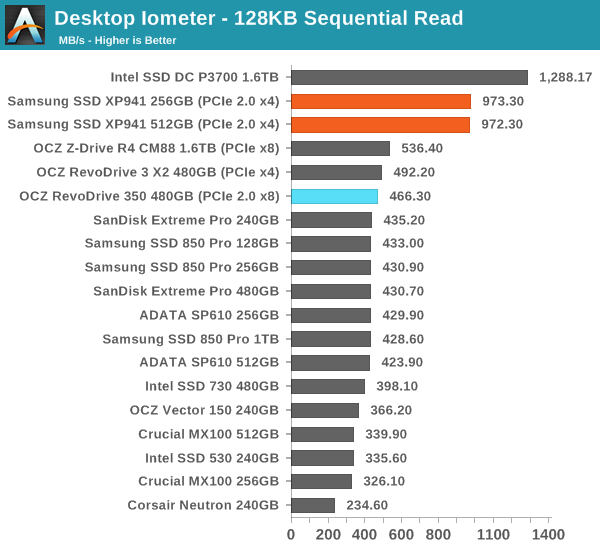
The XP941 continues to be strong, but the RevoDrive still does not offer much benefit over a SATA drive. We are dealing with a QD1 situation here so the RevoDrive cannot really take advantage of its internal parallelism.
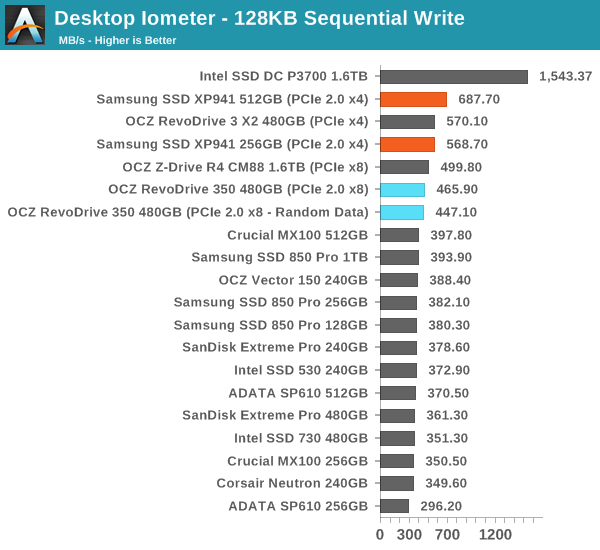
AS-SSD Incompressible Sequential Read/Write Performance
The AS-SSD sequential benchmark uses incompressible data for all of its transfers. The result is a pretty big reduction in sequential write speed on SandForce based controllers, but most other controllers are unaffected.

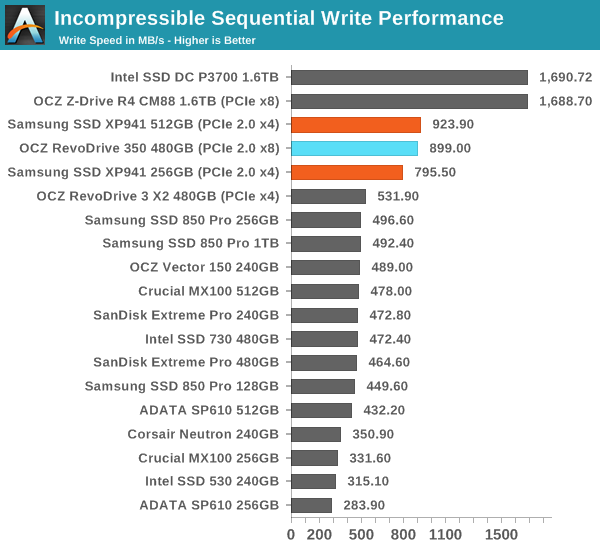










47 Comments
View All Comments
Riemenschneider - Friday, September 5, 2014 - link
I like the M.2 form factor a lot, just a shame that there are so few ITX boards with support, not for FM2+ and also not for the SoC stuff :(. No real reason to go for a M.2 drive yet, though, but that is going to change as soon as the NVMe SSDs are going to be released.hojnikb - Saturday, September 6, 2014 - link
I wonder why OCZ didn't went with their barefoot controller (the one in vector150) instead of sandforce. Sandforce is getting really dated now and using it in a premium product like revodrive is kinda silly in 2014.themeinme75 - Saturday, September 6, 2014 - link
I would like you to add this drive to the review. It reads and writes at nearly 2GB/s.. i not positive it's bootable. It basically 4 ssd in raid. I wonder if someone is working on a pcie3 that would hold 4 1TB m.2 so you get 4tb bootable with like 4GB/s...Mushkin Enhanced Scorpion Deluxe MKNP44SC240GB-DX PCIe 240GB Internal Solid State Drive (SSD) PCIe 2.0 x8 $456.31
Mushkin · Internal · 240 GB · Solid State
Other capacity options: 480GB ($700) 960GB ($1,071) 1920GB ($1,747)
TelstarTOS - Saturday, September 6, 2014 - link
Still waiting for Intel 3600 test at low capacities (I think 400GB is the lowest) which has a decent pricepoint and it should be slightly better than the SP941 512GB.isa - Saturday, September 6, 2014 - link
Looking forward to NVMe PCIe M.2 SSDs, but I'm really disappointed in the pricing so far: one can get a 2.5 inch SATA SSD for about $0.50/GB, and while I'd thought that the M.2 format would afford significant cost savings, these SSDs are over $1/GB. Is that just a temporary supply/demand artifact, or is there some kind of huge licensing cost or additional tech complexity costs that hit M.2 that doesn't hit 2.5 inch SATA?TheinsanegamerN - Saturday, September 6, 2014 - link
A mix of it being brand new technology, low demand (there's, what, 3 non 2011 boards that use it, and a handful of laptops) vs the high demand for data 3 ( every computer made today) and a lack of manufacturers. Most are still making data drives, so those that make m.2 can command a price premium.TheinsanegamerN - Saturday, September 6, 2014 - link
Data 3, not data 3. When will anandtech conceive an edit button?TheinsanegamerN - Saturday, September 6, 2014 - link
Sata is a word, android. Stop autocorrecting.Beany2013 - Sunday, September 7, 2014 - link
It's OK, it was clear from the context as to what you meant :)I think I'll be waiting for M.2 to become more commonplace before updating my current rig (A8-3870, 16gb RAM, SSD 830) then as there's unlikely to be any real performance/£ increase until the earth moving CPUs are dropped/replaced, and PCIe SSDs are more common/cheaper.
(Yes, I like my AMD hardware because I'm cheap and like lots of real threads)
The performance numbers we're seeing from these - effectively first generation - devices are very encouraging though, so I'm looking forward to that point in perhaps two years time when I can throw £500 at a build and get another machine that is hilariously quick for the money.
fredey - Sunday, September 7, 2014 - link
If I didn't already miss it I would like to see a raid round up the the revodrive 350 the mushkin skorpion deluxe and a standard sata 6Gbps setup with something along the lines of four samsung 850 pros in raid 0